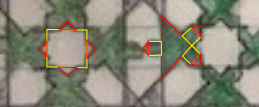Gibraltar Geometry
Take a look at the photos of tiles at a school in Gibraltar. What questions can you ask about them?
Problem
Take a look at the picture below, showing some tiles at Bayside Boys' School in Gibraltar.
Image

What mathematical questions occur to you?
Here is a close up of a section of the tiled wall.
Does this help you to answer any of your questions?
Does it prompt any new questions?
Image

Becky is approximately 1.7m tall. She is standing by the tiled wall.
Does this help you to answer any of your questions?
Does it prompt any more questions?
Image

Here are some questions we thought of:
What geometric shapes are there in the tiles?
What angles can you work out?
How many squares are there?
How many eight-pointed stars?
Can you recreate a copy of the tile on plain paper?
How big are the tiles?
How many rectangular tiles would you need to tile your classroom?
The tiles are an example of a type of pattern commonly found in Islamic Art.
Getting Started
What can you see in this picture?
Image

Can you recreate a copy of the tile on squared paper?
Student Solutions
We received some more interesting questions about the tiles:
How many lines of symmetry are there?
What is the ratio of green to white?
What area do the patterns cover?
Is there a specific name for a pattern that repeats in this way?
Can you answer any of them?
Darcy from St Stephens School in Australia found 350 8-pointed stars in the mosaic.
Kushan from Southbury Elementary School in the USA described the shapes in a different way, and recreated the pattern.
I think it's made up of squares and triangles because the octagonal stars have four triangles at the edge and the "froggy" shapes have a big triangle with three squares poking out of the sides with triangles at the edges. Please see my drawing to locate the shapes.
Image

Here are the squares and triangles Kushan describes:
Image

Abigail and Bella from St Stephens Carramar in Australia also sent in their work:
We are trying to figure out the size of the tiles:
Each tile is 24cm long. We did this by drawing a line from her head to her toes (where we predicted they would be).
We knew she was 1.7 meters tall so, so we rotated the line we had drawn and counted how many tiles were fitted along the line: 7
So we divided 1.7 by 7 and we got 24 cm.
Image

JEloise, also from St Stephens Carramar, posed and answered a different question using Becky:
How much space does Becky take up on the tiled wall?
How we found the answer:
Step 1: Find someone/something that measures 1.7 m
Step 2: Measure from their elbows to their ankles
*Becky takes up $2 \frac12$ average sized bricks*
Step 3: Measure the length of $2 \frac12$ average sized bricks (that equals her width)
Step 4: Length $\times$ width = her estimated area
Step 5: Find out the length of elbows to just above the knees
Step 6: Height from above the knees to the elbows x overall width *we use
that number later*
Step 7: Figure out the height from above the knees to the ankles
Step 8: Add step 6 & 7 number together = estimated area Becky takes up
*the next few steps is how to make it more accurate. If you're not interested in it, stop here and you'll have the rough answer of how much space she takes up*
Step 9: Figure out the measurement of both legs combined *including the gap*
Step 10: figure out measurements of both size gap *top and bottom*
Step 11: Subtract gap size from the leg measurements. = How much space Becky takes up on the tiled wall.
This is how we got our final answer.
*we had a friend that was exactly 1.7m so it made it easy to predict Becky's size, this formula may not work for everyone*
Teachers' Resources
Why do this problem?
In this problem, we present a photograph that has lots of intriguing patterns that we hope will provoke students' curiosity and prompt them to ask mathematical questions.The main mathematical themes are tiling, tessellation and symmetry, but there is also an opportunity to think about area and estimation by considering how many tiles would be needed to cover a particular area.
Possible approach
Show the first picture:Image

Give students a little while to look at it, and then share the closeup showing detail of the tiles:
Image

Give students a bit more time to look at it, and then invite them to share mathematical questions that occur to them.
Here are some that might arise:
- What geometric shapes are there in the tiles?
- What angles can you work out?
- How many squares are there?
- How many eight-pointed stars?
- How big are the tiles?
- How many rectangular tiles would you need to tile your classroom?
The third picture gives some context by positioning Becky, who is 1.7m tall, in front of the tiles. This opens up the possibility of estimating the size of the tiles, and the number that would be needed to cover a given area.
Image

Key questions
What can you see?What mathematical questions do you want to explore?
